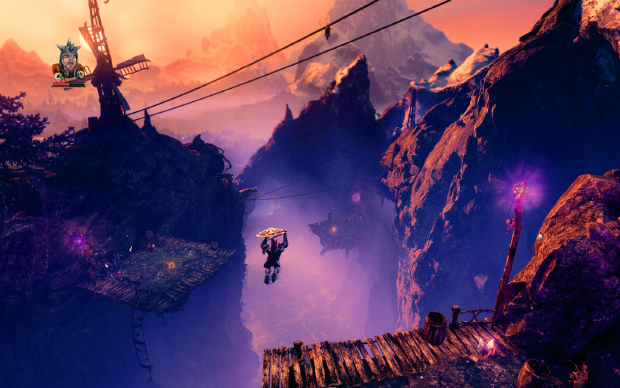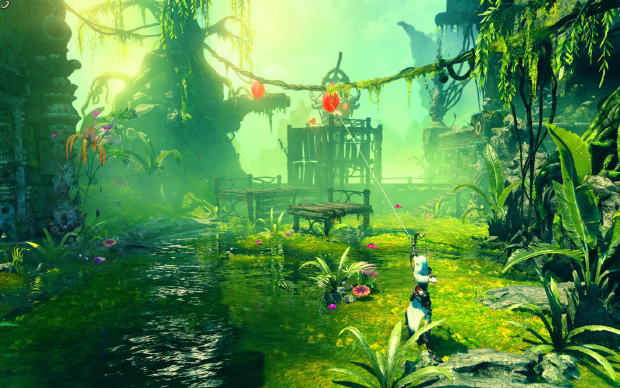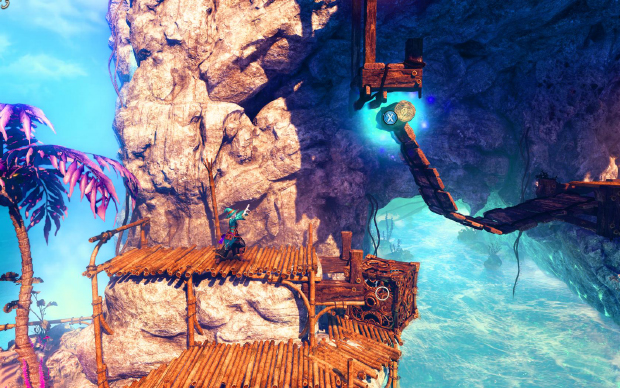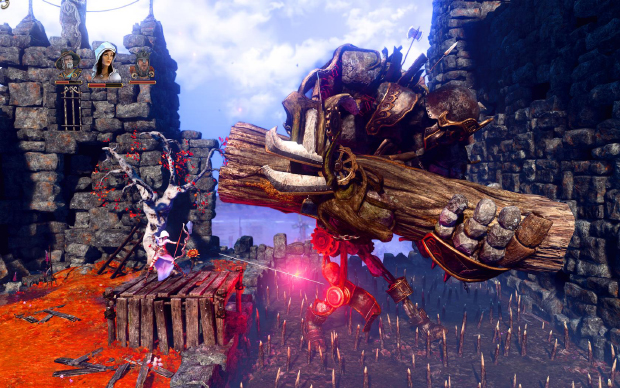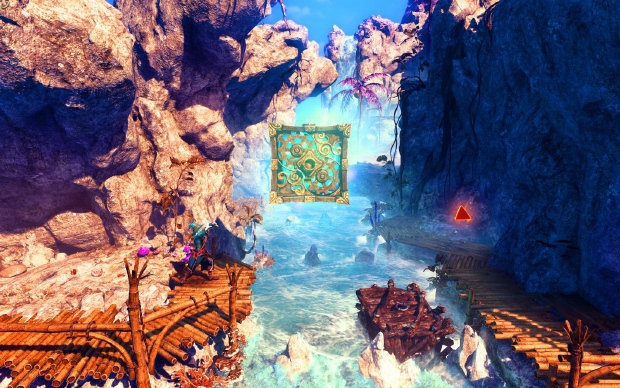Premature Evaluation: Trine 3
Tri-hard With A Vengeance
Each week Marsh Davies swings gamely into the haunted temple of Early Access and brings back any stories he can find and/or tumbles indecorously onto a bed of wooden stakes. This week: third time’s the charm (maybe) for the triply protagonist’d physics-platforming sequel, Trine 3: The Artifacts of Power.
Frozenbyte have really tripled-down on the rule of three: three games, three protagonists and, now, three whole dimensions. Preceding games in the series have reserved the x-axis for set-dressing, sumptuously parallaxing behind the co-op-enabled chaos unfolding in a fixed plane, left-to-right. Now they’ve added depth, at least in a literal sense, and they want fan feedback on how well this works. To whit, a roughly hewn slab of game is now available on Early Access, reuniting the game’s three interchangeable but asymmetrically-talented heroes for a little over two hours. It’s unabashedly buggy and part-implemented - the proposition phrased as though it were a tentative proof of concept or a wild experiment. This is a reasonable use of Early Access, I think, although not an especially cheap one for eager beta-testers, and, given the quantity of the existing game and the predicted late-2015 launch date, it doesn’t look like an experiment from which Frozenbyte could now easily back away (along the y-axis, one assumes).
The results are very mixed - though, as I will explain later, I don’t know whether that matters. Clearly what that third dimension brings is a better sense of being in the world, more dynamism to the game’s brief melee interludes, and some stand-out moments of glitz - your avatar leaping from a platform to glide into the sunset, centre-screen, for example. But there are no shortage of instantly evident problems with it, problems that have existed since I first over-eagerly wahoo’d to my death in Super Mario 64. The incoming slew of VR goggles may finally put paid to one of these issues: judging depth on a 2D display with any precision is extremely hard, and even more so here, where the viewing angle is out of your control. Leaps from platform to platform do not always align as you might expect, sending you to your death - and yet, for very large portions of the game, it relies on lateral movement in a fixed plane anyway, making the addition of depth little more than an additional opportunity for failure residing just beyond the player’s ability to intuit.
The Trine games have always been big on physics, preferring the freeform fun of fritz-prone object manipulation to pat, precise puzzling. Historically, this has meant that attempting to deposit a counterweight just so with a character’s inelegant shoulder-barge has often felt like trying to hammer in a nail with a sausage. And so it is here, but now the nail is a sausage, too, thanks to the additional dimension into which objects can erratically spring. Several puzzles in the Early Access build had me second-guessing the solution because it involved such an ugly flail of unpredictable physics interactions. Just to roll a block up a slope away from the camera is to prostrate yourself before the unknowable repercussions of collision detection.
I mention this because these seem like big problems inherent to the nature of 3D platforming that are simply hard to solve. There are minor complaints, too, as with any Early Access release - it’s easy to fall behind scenery in many of the game’s environments, for example. But I’m not worried about that. I’m worried about the fact that the wizard character, whose skill is to telekinetically manipulate objects, cannot telekinetically manipulate objects in the three dimensions required with consistency - because that is a fundamentally difficult thing to articulate through the control of a single analogue stick. The thief, Zoya, can fire arrows in 360 degrees, but, with the addition of 3D, full free-aim is necessarily replaced by an auto-lock that mostly predicts your intention - again a tricky problem to unpick given the control constraints. Not intractable, but tricky.
Now it could be that this is exactly the kind of issue that the Early Access process is intended to identify and address, but then again the Trine series has always been a bit of an inelegant faff of floaty, inexact platforming and fickle physics interactions. Part of the games’ problem - and perhaps their appeal - is that the trio of mismatched adventurers create a possibility space for which the puzzles just don’t manage to account. In singleplayer you control one at a time but can switch between them on the fly: Zoya can fire arrows, grapple onto hooks, swing across gaps, tether herself to objects and yank them around; Amadeus the wizard can conjure blocks from the air and move them, or others, telekinetically; Pontius the knight can hit things with his sword and use his shield as a hang-glider. The variance of these abilities allows for player ingenuity to trump the designers’ plans in gratifying ways, but it also allows you to bludgeon puzzles to bits by spamming wizard-blocks until one catches on a piece of scenery and allows you to scramble gracelessly past whatever more subtle interaction was intended. Equally, it’s hard to judge when a puzzle is actually impossible without a certain character, who may have died, requiring a checkpoint reset.
Co-op, which places up to three Trine heroes in simultaneously play, makes things even harder to predict, and so the games simply haven’t tried. That seems true again here. A goodly number of the puzzles on the critical path can be solved by the wizard transporting a colleague on a floating box, or otherwise trivialising the design. As a sop to co-op players, puzzles off the critical path do sometimes require multiple actors. But only sometimes. As a lonesome player, can you be sure when this is the case or when a puzzle is just a fudgesome mess?
But, I put it to you that Trine’s appeal has never been precise puzzling or platforming. Rather, the game’s charm is as a bit of co-op fluff set amid some of the most ostentatiously beautiful scenes in gaming. It doesn’t need to have pat solutions when the cooperation required to airlift your partner over some spikes can offer a choatic sort of fun by itself. The Lego games also often get a free pass in this regard: mechanically, they have been (at least until very recent installments) the most mechanically barren digi-gash, but forgiven by some for their cute appropriation of pop culture and the fact that their lack of any discernible friction mitigates everything that’s awful about them - which is, in fact, everything, right down to the flabby, floaty parabola of every jump.
Co-op heals all: not in a way which is particularly a credit to the designers, but simply as a social distraction from the flaws of the game. This is why, even in games which have consciously and carefully considered the interplay between two players, like Portal 2, the best part is still when you repeatedly drop your mate into acid, despite promising that you won’t, every time. No, really, that was the last time, honest. I’ll be sensible now. Splash!
Trine has this in spades, of course. And a not inconsiderable addendum to this is just how luxurious its environments look and feel: it’s a pleasure just to be there, in its hypersatured land of smokey sunbeams, succulent vegetation and cascading water. Crystals emit blooms of lurid purple light, suns settle into a fuschia haze. Everything is so intense, exaggerated to extreme, and yet deftly avoids looking gaudy. This is no small aesthetic feat.
The writing, by contrast, feels defiantly bland. Trine is a satire of fantasy tropes which, for all its apparent jollity and lack of self-seriousness, somehow fails to land a single joke. The closest thing to a witty line in the Early Access build is when our heroes find themselves tasked with rescuing a magic academy from peril and Zoya complains that she’s already stolen all the good stuff from there. It’s not the sort of zinger you have to duck, is it? Still, ideally I suppose, whatever the characters have to say is intended to be drowned out by the yelps and shouts and swearing of the people playing it. Honestly, I won’t drop you in the pit. No, really. That was the last time. Promise.
Trine 3 is available from Steam for £15. I played v0.01 on 23/04/2015 but it has since been patched. Please find a changelog here.


